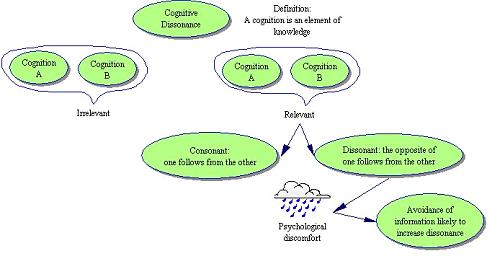Cognitive dissonance theory

Cognitive dissonance theory
Acronym
CDT
Alternate name(s)
Dissonance Theory, Cognitive Consistency Theory
Main dependent construct(s)/factor(s)
User satisfaction, performance, perception, behavior, usage
Main independent construct(s)/factor(s)
Expectations, disconfirmation, attitude, belief
Concise description of theory
Cognitive Dissonance Theory, developed by Leon Festinger (1957), is concerned with the relationships among cognitions. According to cognitive dissonance theory, there is a tendency for individuals to seek consistency among their cognitions (i.e., beliefs, opinions). When there is an inconsistency between attitudes or behaviors (dissonance), something must change to eliminate the dissonance. In the case of a discrepancy between attitudes and behavior, it is most likely that the attitude will change to accommodate the behavior.
Two factors affect the strength of the dissonance: the number of dissonant beliefs, and the importance attached to each belief. There are three ways to eliminate dissonance: (1) reduce the importance of the dissonant beliefs, (2) add more consonant beliefs that outweigh the dissonant beliefs, or (3) change the dissonant beliefs so that they are no longer inconsistent.
Dissonance occurs most often in situations where an individual must choose between two incompatible beliefs or actions. The greatest dissonance is created when the two alternatives are equally attractive. Furthermore, attitude change is more likely in the direction of less incentive since this results in lower dissonance. In this respect, dissonance theory is contradictory to most behavioral theories which would predict greater attitude change with increased incentive (i.e., reinforcement).
Source: http://tip.psychology.org/festinge.html
Diagram/schematic of theory
http://www.people.vcu.edu/~rmreardon/601/601session04.htm
(c) Scott Adams, Inc.
Originating author(s)
Leon Festinger
Seminal articles
Festinger, L. A. Theory of Cognitive Dissonance, Stanford University Press, Stanford, CA, 1957.
Festinger, L. and Carlsmith, J. M. "Cognitive Consequences of Forced Compliance", Journal of Abnormal and Social Psychology (58), 1959, pp. 203-210.
Brehm, J. and Cohen, A. Explorations in Cognitive Dissonance, Wiley, New York, 1962.
Wickland, R. and Brehm, J. Perspectives on Cognitive Dissonance. Halsted Press, New York, 1976.
Originating area
Psychology
Level of analysis
Individual
IS articles that use the theory
Bassellier G., Reich B. H. and Benbasat, I. "Information technology competence of business managers: A definition and research model," Journal of Management Information Systems (17:4), 2001, pp. 159-182.
Bhattacherjee, A. "Understanding information systems continuance: An expectation-confirmation model." MIS Quarterly (25:3), 2001, pp. 351-370.
Bhattacherjee, A. and Premkumar, G. "Understanding changes in belief and attitude toward information technology usage: a theoretlcal model and longitudinal test." MIS Quarterly (28.2), 2004, pp. 229-254.
Iivari, J. "An empirical test of the DeLone-McLean model of information system success," Database for Advances in Information Systems (1), April 2005, pp. 8-27.
Karahanna E., Straub D. W., and Chervany, N. L. "Information technology adoption across time: A cross-sectional comparison of pre-adoption and post-adoption beliefs." MIS Quarterly (23:2), 1999, pp. 183-213.
Livingstone L. P., White M. A, Nelson D. L. and Filiz, T. "Changes in attitudes toward an information systems innovation: Reactions to implementation delays," American Business Review (20:2), 2002, pp. 80-88.
Oinas-Kukkonen, H. and Harjumaa, M. "Persuasive Systems Design: Key Issues, Process Model, and System Features," Communications of the Association for Information Systems, Vol. 24, Article 28, pp. 485-500.
Palanisamy, R. "Strategic information systems planning model for building flexibility and success," Industrial Management + Data Systems (105:1/2), 2005, pp. 63-81.
Pavlou P. A. and Gefen, D. "Psychological contract violation in online marketplaces: antecedents, consequences, and moderating role." Information Systems Research (16:4), 2005, pp. 372-399.
Spathis, C and Ananiadis, J. "Assessing the benefits of using an enterprise system in accounting information and management," Journal of Enterprise Information Management (18:1/2), 2005, pp.195-210.
Spreng R. A. and Page T. A., Jr. "A test of alternative measures of disconfirmation," Decision Sciences (34:1), 2003, pp. 31-62.
Staples, S. D., Wong I. and Seddon, P. B. "Having expectations of information systems benefits that match received benefits: Does it really matter?" Information & Management (40:2), 2002, pp. 115-131. .
Links from this theory to other theories
Expectation confirmation theory, Cognitive fit theory
External links
http://en.wikipedia.org/wiki/Cognitive_dissonance#Two_kinds_of_dissonance, Wikipedia entry
http://www.tcw.utwente.nl/theorieenoverzicht/Theory%20clusters/Interpersonal%20Communication%20and%20Relations/Cognitive_Dissonance_theory.doc/, Twente University entry
Original Contributor(s)
Anna Alon
Please feel free to make modifications to this site. In order to do so, you must register.
Return to Theories Used in IS Research

